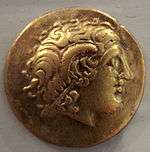Salyes
The Salyes (also Salluvii) (Greek: Σάλυες) were an ancient Ligurian confederation that occupied the plain of the Druentia (Durance) in southern Gaul between the Rhône River and the Alps. They are said to have been the first transalpine people subdued by the Romans.[1]
Name
They are mentioned as Sallyas by Caesar (mid-1st c. BC),[2] as Saluum, Salluvii and Saluium by Livy (late 1st c. BC),[3] as Salúōn (Σαλύων) by Strabo (early 1st c. AD),[4] as Salluuiorum and Sallui by Pliny (1st c. AD),[5] as Sálues (Σάλυες; var. Σάλικες) by Ptolemy (2nd c. AD),[6] and as Salyes by Avienus (4th c. AD).[7][8] The oldest form may have been Salyes, later Latinized into Salluvii.[8]
The origin of the name remains obscure.[8]
History
The hill-top oppida originally inhabited by Ligures at the time of Massilia's foundation about 600 BC, which were strung out between the fords of the Rhône and Durance and the approaches to the Alpine passes, were not bound together by any uniting force; according to Strabo the older Greeks called these people Ligyes, and their territory Ligystike. Celtic cultural encroachments from the mid-3rd century BC are revealed in the archaeological record,[9] and by the time of Strabo some authorities considered them a "mixed race" of Galli and Ligurians (hence Celtoligyes).[1]
They joined Bellovesus' migrations towards Italy, together with the Aeduii, Bituriges, Ambarri, Arverni, Aulerci, Carnutes and Senones.[10]
In 154 BC the Hellenic inhabitants of Massilia, who had been connected with the Romans by ties of friendship since the Second Punic War, appealed for aid against the Oxybii, who controlled the Argens valley and Decietes (or Deciates). These people, called by Livy "transalpine Ligurians", were perhaps two smaller tribes included under the general name of Salyes. They were defeated by the Roman consul Quintus Opimius. In 125–124 hostilities broke out once more between the Romans and the Salyes from the same cause. The successful operations of Marcus Fulvius Flaccus were continued by Gaius Sextius Calvinus (123–122), who definitely subdued the Salyes, destroyed their chief town at the site of Entremont, north of Marseille, which reverted to rural occupation, and founded near its ruins the colony of Aquae Sextiae (Aix-en-Provence). Part of their territory was handed over to the Massaliotes. Their king, Tutomotulus (or Teutomalius), took refuge with the Allobroges. From this time the Salyes practically disappear from history.[1]
In addition to the capital of the Salyes at Entremont, where two major routes crossed, the inland route from the fords of the Durance to the Alpine valleys and the natural coastal route linking Italy and Hispania, among other important Roman towns in their territory may be mentioned Tarusco or Tarasco (Tarascon), Arelate (Arles), Glanum (Saint-Rémy-de-Provence) and Ernaginum (Saint-Gabriel, now part of Tarascon).[1]
References
-

- Caesar. Commentarii de Bello Gallico, 1:35:4
- Livy. Ab Urbe Condita Libri, 5:34:7; 35:2; 21:26:3
- Strabo. Geōgraphiká, 4:6:3
- Pliny. Naturalis Historia, 3:36; 3:47
- Ptolemy. Geōgraphikḕ Hyphḗgēsis, 2:10:8
- Avienus. Ora maritima, 701
- Falileyev 2010, p. entries 3621 and 3622.
- Fernand Benoît, "The Celtic oppidum of Entremont, Provence" in Rupert Leo Scott Bruce-Mitford, ed. Recent archaeological excavations in Europe (London, 1975), pp. 227ff.
- Livius, Ab Urbe condita 5.34–35.3.
Bibliography
- Falileyev, Alexander (2010). Dictionary of Continental Celtic Place-names: A Celtic Companion to the Barrington Atlas of the Greek and Roman World. CMCS. ISBN 978-0955718236.
